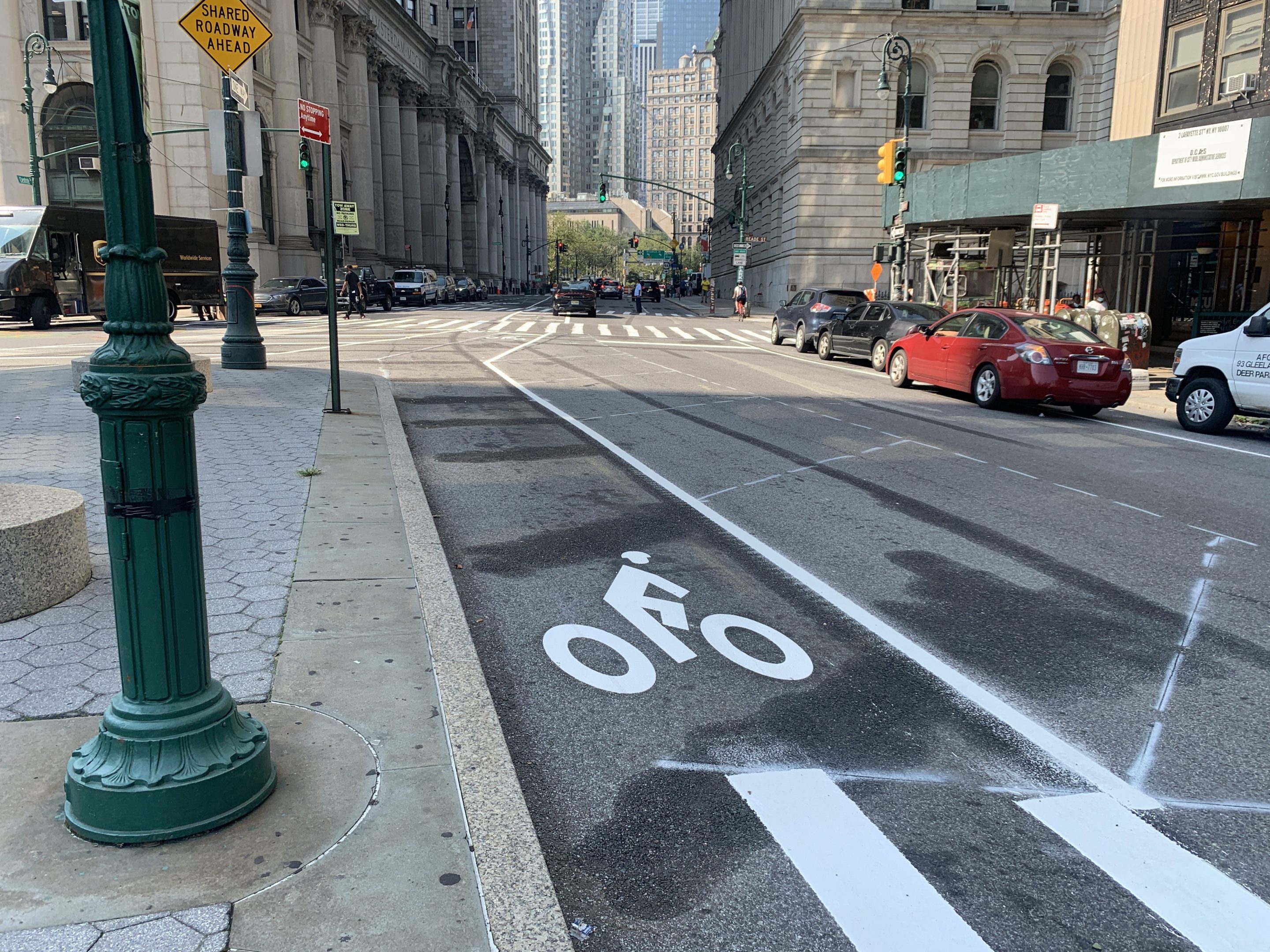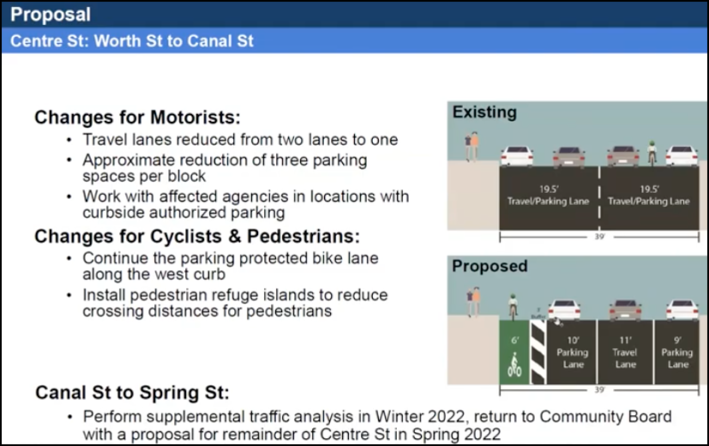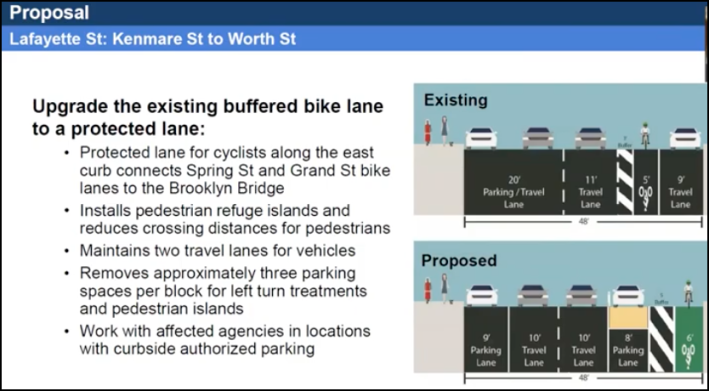The Brooklyn Bridge bike lane is here, but cyclists might have to wait 'til next year for a safer connection to and from it.
Presenting the plans for protected bike lanes on Centre Street and Lafayette Street to Community Board 1's Transportation Committee last week, Department of Transportation planner Patrick Kennedy said the goal is to fill in a gap in lower Manhattan's bike network to provide more secure connections — and the a best-case scenario could result in protected bike lanes running further north on Centre Street and south on Lafayette Street this year.
On Centre Street, the newly installed protected connection from the Brooklyn Bridge will be joined by a northbound protected bike lane from Worth Street to Canal Street — a bike lane that will attempt to calm five key blocks where there were an astounding 248 reported crashes from 2017 through 2019, injuring nine cyclists, 22 pedestrians and 16 motorists, killing one pedestrian, according to Crashmapper.
Eventually, that protected bike lane will go north of Canal Street to Kenmare Square, a key improvement because northbound cyclists currently have only one way of getting to the eastbound Grand Street protected bike lane: by riding on the dangerous part of Centre north of Canal. Between 2017 and 2019, there were 56 reported crashes on that single, critical block, injuring eight cyclists, two pedestrians and one motorist.
Good news of course but also, wow is it painful to watch them just now move a project forward that was obvious a solid decade ago.
— paco (dave) abraham (@subtle116) September 20, 2021
"If the stars align we can get this in this year," Kennedy said about the entire Centre Street project on Tuesday. "If we can get this to our contractors and they can get it done this year, we want to get it done. That being said, it is very late in the season and we have to have everything go perfectly in order for that to happen. If it doesn't, we'll be doing it first thing out of the gate in the spring to get this whole thing done."
Even if the Centre Street extension does reach Canal Street this year, Kennedy said that an initial attempt to build a bike lane up the street was not working, but that the DOT is looking for new traffic modeling from a rejiggered Centre to inform a better design north of Canal.
"When we were doing our analysis it was before the Brooklyn Bridge project started, and what we found was that we were having to make too many compromises in the design because the traffic analysis was not working out. We know the Brooklyn Bridge has created a very different existing condition for traffic on Centre Street, going from two lanes feeding down to one, so our plan for north of Canal is we're going to reanalyze this over the winter and hopefully have a better design," he said.
The DOT did not respond to a question as to when the Centre Street and Lafayette Street project was initially planned, and whether it was interrupted by the work needed for the Brooklyn Bridge bike lane.
The city will cut the motor vehicle lanes on Centre from two down to one in the section between Worth and Canal, and will also install pedestrian island at every intersection along the way. While the illegally-parked elephant in the room wasn't part of the DOT's initial presentation, Transportation Committee co-chair Michael Francoeur asked Kennedy what the agency's plan was to deal with future placard abuse on the illegal parking hotspot that is Centre Street.
Kennedy said that the DOT's version of being proactive while dealing with illegal parking is first trying open communication with other agencies. Failing that, the design changes get hauled out.
"We try to work with other agencies to try to say, 'Hey you might want to tell your employees to park elsewhere.' Part of it is reaching out to local precincts to reach out and say, 'Hey, just tell your employees to park in the spot where we told you to.' Our first thought it is to try to be friendly and work with our other agencies. If that doesn't work or we have continuing problems, we have design-based solutions. For pedestrian spaces we can put planters, granite blocks, bike rack sleds we can put in to a space to make it difficult to put a car in that space. We always try to work with our fellow agencies to solve a problem peacefully and in a friendly way, but there are ways we can use a design based solutions to address issues if they continue to occur."
But critics say it's time to move past the diplomatic approach and just design for war with drivers.
"City traffic law enforcement was weak when DOT started a real bike program nearly 15 years ago, and it’s almost nonexistent now," said Bike New York Director of Communications Jon Orcutt, a former DOT planner. "It’s past time to stop pretending the law will keep cars and trucks from street space designed for other uses."
On Lafayette Street, southbound cyclists will get a protected lane from Kenmare Street to Worth Street, which will form a connection with the new protected bike lane on the west side of Foley Square, which is going in now, as many eagle-eyed New Yorkers noticed this week:
Look what I just saw: bike lane on Lafayette getting flipped & protected! Lafayette 2 Bklyn Br at Worth. @bblytherss @JanetLiff @BarmanNYC @12stTales @PaulKrikler pic.twitter.com/C6Mg99uiN9
— @bikeloveny@post. (@bikeloveny) September 15, 2021
North of Worth Street, the city will simply flip the parking lane and the existing bike lane, calming a stretch where there have been 381 crashes between 2017 and 2019, injuring eight cyclists, 20 pedestrians and 24 motorists, according to Crashmapper.
That project is being done by a different contractor than the one working on Centre Street. Kennedy said he was hopeful that the bike lane on Lafayette north of Worth could be finished by the end of this year, but it may have to wait until 2022.
"Being realistic, it may get pushed because of weather or unforeseen issues," he said.
When completed, both bike lanes will link the Brooklyn Bridge with Soho, though the next mayor will still have to take care of filling in the gap on Lafayette north of Spring Street.








